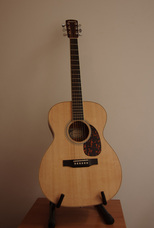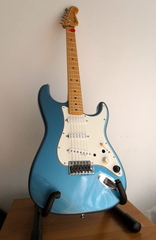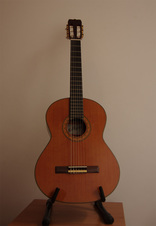Guitar-buying advice for beginners
Here's some advice for beginners buying a first guitar.
(Check out this article if you have been playing some time, and are interested in buying a second-hand guitar).
Know the different types of guitar, their sounds and the styles that are commonly played on them.
Basically, there are three types of guitar – acoustic, electric and classical.

Acoustic guitar - also called a steel-string or a Western.
Styles usually played on an acoustic - singer-songwriter, folk, blues, unplugged rock, country, around the campfire sing-a-longs...
A type of acoustic guitar is an electro-acoustic. An electro-acoustic is an acoustic guitar which can be plugged into an amplifier or P.A. system to sound louder when playing a gig.
Styles usually played on an acoustic - singer-songwriter, folk, blues, unplugged rock, country, around the campfire sing-a-longs...
A type of acoustic guitar is an electro-acoustic. An electro-acoustic is an acoustic guitar which can be plugged into an amplifier or P.A. system to sound louder when playing a gig.

Electric guitar
Styles usually played on an electric - rock, jazz, blues, funk, reggae, soul, metal, country...
If you buy an electric guitar, you’ll probably want to get an amplifier and a cable to go with it. It is possible to practice on an unamplified electric guitar, and this could be an option for a start if you are on a budget. But, to be louder and to get the real sound of the electric guitar, you’ll need an amp. The amp could be a small one, say 5 or 10 watts, which is ideal for practicing in the home. If you start to play with a band you would need a louder one.
You may come across the term semi-acoustic when researching electric guitars. A semi-acoustic guitar is an electric guitar with a hollow body. Like an electric, they sound best when plugged into an amp.
Styles usually played on an electric - rock, jazz, blues, funk, reggae, soul, metal, country...
If you buy an electric guitar, you’ll probably want to get an amplifier and a cable to go with it. It is possible to practice on an unamplified electric guitar, and this could be an option for a start if you are on a budget. But, to be louder and to get the real sound of the electric guitar, you’ll need an amp. The amp could be a small one, say 5 or 10 watts, which is ideal for practicing in the home. If you start to play with a band you would need a louder one.
You may come across the term semi-acoustic when researching electric guitars. A semi-acoustic guitar is an electric guitar with a hollow body. Like an electric, they sound best when plugged into an amp.

Nylon-string classical guitar
Sometimes called a Spanish or concert guitar.
Styles usually played on a classical guitar - classical, flamenco, rumba, bossa nova.
Strictly speaking, a classical guitar is an acoustic guitar, but the term 'acoustic guitar' is usually used when talking about steel-string acoustic guitars.
*Many beginners in the past have bought a classical guitar when they should have bought an acoustic guitar. They've then found it difficult to play some acoustic guitar material convincingly on their classical guitar (especially strumming with a pick, which can sound bad). Most end up buying an acoustic guitar later anyway.
* I play and teach nylon-string guitar, but only for modern styles – Bossa Nova, Jazz, chilled-out pop (Sting, Norah Jones, for example). I’m afraid I don’t have a repertoire of classical pieces and I don’t play flamenco guitar at all. I'm sure there are better-suited teachers around than me if you’d like to learn classical or flamenco guitar the traditional way.
Here are a couple of audio examples to help you discern between the different styles and sounds of acoustic and classical guitars:
Acoustic
Sometimes called a Spanish or concert guitar.
Styles usually played on a classical guitar - classical, flamenco, rumba, bossa nova.
Strictly speaking, a classical guitar is an acoustic guitar, but the term 'acoustic guitar' is usually used when talking about steel-string acoustic guitars.
*Many beginners in the past have bought a classical guitar when they should have bought an acoustic guitar. They've then found it difficult to play some acoustic guitar material convincingly on their classical guitar (especially strumming with a pick, which can sound bad). Most end up buying an acoustic guitar later anyway.
* I play and teach nylon-string guitar, but only for modern styles – Bossa Nova, Jazz, chilled-out pop (Sting, Norah Jones, for example). I’m afraid I don’t have a repertoire of classical pieces and I don’t play flamenco guitar at all. I'm sure there are better-suited teachers around than me if you’d like to learn classical or flamenco guitar the traditional way.
Here are a couple of audio examples to help you discern between the different styles and sounds of acoustic and classical guitars:
Acoustic
Classical
I don’t believe that any one of the three types of guitar - electric, acoustic or classical - is the best to begin playing. Just go for the type that you personally like the best and that you are motivated to play.
Buy a new guitar from a high street or online store rather than from Ebay or a private seller - it's safer, you stand a better chance of getting a good guitar that plays well. If you don't know a lot about guitars, then buying a second-hand guitar is a lottery!
If buying an acoustic guitar, I suggest you get a 'solid top' (sometimes called 'massif' in French), which sound much better than cheaper guitars which normally have a 'laminate top'. Good brands making solid top acoustics at a decent price (300 to 700 euro) are Seagull, LAG, Yamaha and Sigma.
If buying an electric guitar, then I would recommend getting a Yamaha Pacifica guitar and a Roland Cube practice amp.
I'd also recommend Yamaha as a brand is you are buying a classical guitar. Their quality is about the best around the 300 euro price range in my opinion.
Shopping local vs shopping online??? Ethically, I prefer to shop locally in Brussels, if the price difference between a local store and the mega-internet stores (eg Thomann or Music Store, the two big German-owed stores) is not too great.
Some other things you may want to get when buying a guitar
By Mark Baxter
(c) 2008-2023
